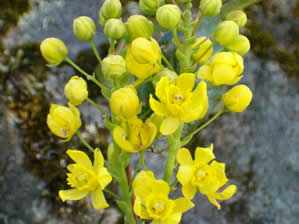UNDERSTANDING SYNONYMS

Dull Oregon grape (Mahonia nervosa), photo by Kevin Newell
by
Jamie Fenneman
Wildlife Biologist and Ecologist
LGL Limited Environmental Research Associates
Sidney, BC
Synonyms Explained:
Why Plants Sometimes Have Other Scientific Names
Go directly to Vascular Plant Synonyms Part I: Cupressaceae to Asclepidaceae
The naming of organisms is a complicated procedure. In many instances, for a variety of reasons, a number of different names may be applied to the same species of organism. These alternative names are known as synonyms of the accepted species name. For example, the cow-parsnip, which we know as Heracleum maximum here in B.C., goes by the name of Heracleum lanatum in Alberta and the Yukon Territory, and even in many older publications from B.C. These two names don’t represent different species, but rather two different names (synonyms) for the same species.
Synonyms arrive for a number of reasons. In some instances, the original author who describes the plant may place it in a particular genus but subsequent authors, often with a more complete understanding of the family and its representatives, may move that species into a new genus, supposedly reflecting a more accurate classification. In this situation, the older name would be considered a synonym of the newer name. For example, DuRoi originally described the Tamarack under the name Pinus laricina (in those days, virtually all needle-leaved conifers were classified as pines, Pinus). Later, K.Koch revised the species name and created a new genus for it and the other larches, Larix. Thus, Pinus laricina DuRoi became a synonym of the new name, Larix laricina (DuRoi) K.Koch. The authors’ names are added after the scientific names in order to clarify the taxonomic history of the species for readers.
Another instance that may result in synonymy is for highly variable or wide-ranging species. Early botanists rampantly named multitudes of new species, subspecies, and varieties from across North America and, in many cases, several botanists ended up describing the same species independently and unknowingly under different names. Or, slight and subtle variations in a species were named as new species before it was understood that many of these were merely the result of natural variation within the species. The result would be a large, and often confusingly complex, synonymy. For example, Alpine Pussytoes (known as Antennaria alpina in B.C.) has a long and complex synonymy due to its wide geographic range, extreme similiarity to related species (such as A.media, A.rosea, A.microphylla, and A.umbrinella), and multitudes of minor geographic and individual variations. The resulting synonymy of this species includes a huge number of species, subspecies, and varieties that are still cause for headaches among botanists today.
The reason that it is important to understand synonyms and to have access to a good synonymy is that there is no universal classification system for plants, even in North America. Unlike birds, where taxonomic decisions are made on a continental level by the American Ornithologists’ Union (AOU) and subsequently adopted from Canada to Central America, there is no single accepted classification scheme for plants anywhere in the world. The Flora of North America project, which is in the process of producing a multi-volume treatise on all species of vascular and non-vascular plants in North America north of Mexico, provides the only current attempt at continent-wide classification of plants, but even this work is not the final word. Many regional authors will continue to use local classifications of plants because of differing taxonomic opinions. Thus, the importance of the synonymy to botanists, ecologists, naturalists, and conservationists is not likely to diminish in the near future.
Note:
The United States Department of Agriculture, Natural Resources Conservation Service’s PLANTS database, providing distributional and taxonomic information on all plant species occurring in the United States, hosts one of the most complete synonymys on the web for North American plants. This information is available at the following address: http://plants.usda.gov/index.html.
Go directly to Synonyms Part I: Cupressaceae to Asclepidaceae
Recommended citation: Author, date, page title. In: Klinkenberg, Brian. (Editor) 2023. E-Flora BC: Electronic Atlas of the Flora of British Columbia [eflora.bc.ca]. Lab for Advanced Spatial Analysis, Department of Geography, University of British Columbia, Vancouver. [Date Accessed]
E-Flora BC: An initiative of the Spatial Data Lab, Department of Geography UBC, and the UBC Herbarium.
© Copyright 2023 E-Flora BC.